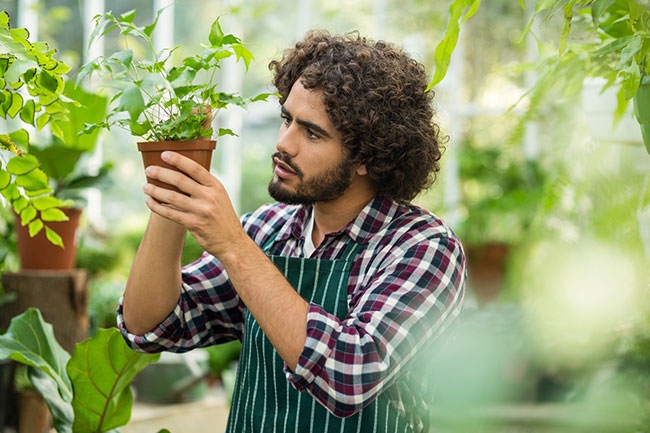
Features
Crops
Flowers
Getting spring crop off to a good start
Be diligent about sanitation and other “clean start” measures, focus efforts on crops that are known pest magnets, and be willing to play a little with production strategies to decrease pest damage.
February 20, 2018 By Drs. Sarah Jandricic and Chevonne Carlow
 Spring is a busy time for growers, but if you never take the time to try out new techniques or technologies, you’ll never know if production can be improved. Photo: Fotolia
Spring is a busy time for growers, but if you never take the time to try out new techniques or technologies, you’ll never know if production can be improved. Photo: FotoliaOverall, 2017 was a pretty good year for Ontario’s spring flower crops in terms of pests. Insects like western flower thrips were fairly low (no heavy fly-ins like in 2016) and more severe diseases were scarce. Here are some tips for how we can keep 2018 going in the same direction.
Start Clean – and Keep it Clean: Unlike 2016, we hardly saw any black root rot (Thielaviopsis), even in highly susceptible crops like calibrachoa last year. Part of this might be attributable to greater awareness of this disease. Growers who had dealt with this before adopted more stringent sanitation practices, and applied prophylactic fungicide drenches. Going into 2018, Fusarium seems like it may be more of a problem that could extend into the spring.
Here are some examples of sanitation measures that work to prevent or reduce the spread of these, and other, diseases:
- Always wash surfaces new plants will be put on with a cleaner to remove any organic matter. This includes benches and floor coverings. Consider power washing where possible. Followed by a disinfectant such as an ammonium chloride compound to help remove any long-term resting spores of diseases.
- Control your fungus gnats. Fungus gnats might just seem like a nuisance, but even moderate levels are a cause for concern, since both the larvae and adults transmit plant pathogens through their excrement, or even just on their legs. (Think of them like the germy toddlers of the insect world.) Keeping them under control prevents a problem in one section from spreading to other places/crops.
- Use new pots and trays where appropriate. This may help reduce disease incidence in highly susceptible crops, since no sanitation measure is 100 per cent perfect.
- Culling or isolating infected plants, especially in propagation. Since curing a disease with chemicals can be a crapshoot (depending on the disease stage, chemicals available, and crop susceptibility), it may be better to immediately throw out any affected cuttings/plants and treat the rest of the area preventatively. This is especially true of root rots, where getting the plants to bounce back can be difficult.
However, disease prevention is not just about keeping things clean. Even with the most stringent practices, it’s almost impossible to have a facility that’s totally free of diseases like Fusarium and Pythium that are rampant in the environment, and can even come from your water supply (e.g. rain water collection). So, it’s also about making sure the environment is an inhospitable to those diseases as possible.
One way to do this is to be familiar with the conditions under which certain diseases thrive, and avoid these in your production practices. For example, black root rot thrives at high pH levels. Keeping your pH between 5.8 and 6.2 is key in supressing this disease, and also helps ensure your plants are getting the most out of their feed. Fusarium likes warm soil temperatures and can survive separately from any plant material on soil particles. One grower tackled his recurring Fusarium issues by raising his potted plants off the tarp on upside down trays, thereby increasing air flow and reducing contact with a potential contamination source.
In terms of insect pests, starting “clean” is also important, but obviously requires a different set of tools. Drs. Michael Brownbridge and Rose Buitenhuis wrote on this in the May 2017 issue of Greenhouse Canada – you can read online here: http://bit.ly/2qRiZDO.
Know Your Crops and Pick Your Battles: Understanding which plants are likely to attract which pests is important for three reasons:
Scouts can focus their efforts.
Spend your IPM dollars where you need it most.
Inform where to make preventive chemical treatments to avoid bigger problems later.
Make Time to Try New Techniques: Spring is a busy time, BUT if you never take the time to try out new techniques or technologies you’ll never know if production can be improved. Setting up small-scale trials is relatively easy, doesn’t require long-term commitment, and can be done with the assistance of a consultant or OMAFRA specialist.
One technique researchers and IPM practitioners are playing with in spring crops is decreasing nitrogen (N) levels. We know that floriculture crops are generally over-fertilized. While this may not result in harm to the plant, fertilizer is a significant cost for producers. Higher nitrogen in plant tissues also means more food for pests, potentially requiring more pest management inputs and increasing risk of crop losses.
In spring 2016, we ran a small study with five common spring bedding plants, to see if we could produce the same quality plant using less fertilizer. Our results showed a reduction to 150 ppm of N (in a 20-8-20 mix) from the usual 300 ppm leads to an increase in plant biomass (dry weight) without any difference in time to flower or overall size of the plant.
Similarly, in 2017 we saw no differences in time to flower or flower height in gerberas, and little difference in potted chrysanthemum canopy height and size after pinching by reducing nitrogen levels. There were no signs of deficiencies at any rate tested (100, 200 and 300 ppm of N in a 17-5-17 mix with micronutrients). Although numbers of thrips were similar between treatments, actual feeding damage from thrips on was lower in 100 and 200 ppm fed-plants.
Conclusions: By being diligent about sanitation and other “clean start” measures, focusing your efforts on crops that are known pest magnets, and being willing to play a little with your production strategies to decrease pest damage, 2018 may be your best spring production year yet.
Drs. Chevonne Carlow and Sarah Jandricic work together at OMAFRA to tackle needs of the floriculture industry. Carlow’s speciality is plant production and the greenhouse environment; Jandricic works on IPM of insect pests and diseases. They combine their specialties to address greenhouse production as a whole.
Print this page

